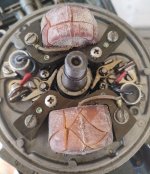Hi, I have been working on a little 6hp Evinrude and I'm in the process of trying to get it to start and idle reliably. I have rebuilt the lower leg which was internally in pretty bad shape. The base of the water pump basically disintegrated when I tried to remove it, looked like someone had taken to it quite aggressively with a wire wheel in the past and it was quite deformed and thinned. Also the clutch dog shifter was missing, or rather had disintegrated and I found bits of it in the skeg.
Anyway the lower leg is rebuilt, completely new water pump and seals throughout. Pumps water well. Remarkably the motor started and I ran it for a half hour or so but it idles way too fast and I'm fairly sure that when it drops from high speed to low, it is just dying, which could be the Carby seals that are disintegrated and the clip on the float pin that is just missing. It will start and run from cold ok, but I have to hold the throttle open enough to stop it from conking out. So it won't really idle by itself. So it could be lots of things so I decided the Carby is next. Pulled it out, cleaned it up, and of course most of the seals within are completely disintegrated too.
So, in order to just troubleshoot and do the next bit next, I'm now rebuilding the Carby with a kit purchased online. The workshop manual and parts diagrams show there are 2 cork ring seals in the low speed needle housing, but all the online videos I watch are different. Some use a rubber o ring, others use one of those red fibre washers. So was hoping someone who actually knows what they're doing could tell me which seal is actually meant to go in there? Just to clarify it's the Carby housing that the long brass idle mixture needle goes into and there is another brass fitting that screws down into it as well.
Also next steps are to pull the flywheel and check, and probably replace the coils and condensers and inspect and clean the points. Can anyone link me a YouTube video on how to pull the flywheel? I'm reading the workshop manual but it's not making much sense to me, don't have a great deal of experience with this. Some of the videos I have seen just gloss over removing the fly wheel and I'm very unsure on how to do it without breaking something.
Thanks for reading.
Anyway the lower leg is rebuilt, completely new water pump and seals throughout. Pumps water well. Remarkably the motor started and I ran it for a half hour or so but it idles way too fast and I'm fairly sure that when it drops from high speed to low, it is just dying, which could be the Carby seals that are disintegrated and the clip on the float pin that is just missing. It will start and run from cold ok, but I have to hold the throttle open enough to stop it from conking out. So it won't really idle by itself. So it could be lots of things so I decided the Carby is next. Pulled it out, cleaned it up, and of course most of the seals within are completely disintegrated too.
So, in order to just troubleshoot and do the next bit next, I'm now rebuilding the Carby with a kit purchased online. The workshop manual and parts diagrams show there are 2 cork ring seals in the low speed needle housing, but all the online videos I watch are different. Some use a rubber o ring, others use one of those red fibre washers. So was hoping someone who actually knows what they're doing could tell me which seal is actually meant to go in there? Just to clarify it's the Carby housing that the long brass idle mixture needle goes into and there is another brass fitting that screws down into it as well.
Also next steps are to pull the flywheel and check, and probably replace the coils and condensers and inspect and clean the points. Can anyone link me a YouTube video on how to pull the flywheel? I'm reading the workshop manual but it's not making much sense to me, don't have a great deal of experience with this. Some of the videos I have seen just gloss over removing the fly wheel and I'm very unsure on how to do it without breaking something.
Thanks for reading.
Last edited:


